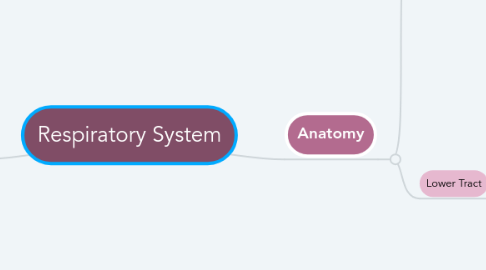
1. Physiology
1.1. Pulmonary Ventrilation
1.1.1. Movement of air in and out of the lungs so that gases in the alveoli and constantly changed and refreshed
1.1.2. Inspiration and development of negative pressure within the chest to allow air to low in down a pressure gradient into the lungs
1.2. Exchange of Oxygen and CO2
1.2.1. Transport of oxygen
1.2.1.1. When PO2 is high oxyhemoglobin bind tightly together and becomes saturated
1.2.1.2. When PCO2 of temperature rises haemoglobin releases oxygen more readily
1.3. Transport of gases in the blood
1.3.1. Transport of Carbon Dioxide
1.4. Regulation of respiration
1.4.1. Control primarily life with neurons in reticular system of the medulla and pots
1.4.2. the medulla oblongata includes the rental respiratory group and the dorsal respirataotry group
1.5. Factors influencing respiration
1.5.1. The rate and depth of breathing is mainly influence by changes in PCO2, PO2, and PH of arterial blood
1.5.2. the branch stem has central chemoreceptors
1.5.3. The aortic arch and carotid arteries have peripheral chemoreceptors
1.5.4. Voluntary control by the cereal cortex
1.5.5. Anxiety, anticipation, and commencing exercise raises respiratory rate and depth
1.5.6. Pain can raise or lower the respiratory rate
1.5.7. Irritation of the pharynx or larynx stops breathing then causes coughing or sneezing.
2. Anatomy
2.1. Upper Tract
2.1.1. moves dust and secrets lysozyme
2.1.1.1. Nose- chamber of speech, nasal cavity and houses the scent
2.1.1.2. Pharynx- passageway for air, houses, and the tonsils.
2.2. Lower Tract
2.2.1. Larynx
2.2.1.1. Voice box
2.2.1.2. Formed with 3 pieces of large cartilege
2.2.1.3. Internal and external laryngeal muscles
2.2.2. Production of sounds
2.2.2.1. the mucus membrane of the larynx forms as upper pair of vestibular folds and the lower vocal folds. The vocal cords are elastic ligaments stretched between rigid cartilage.
2.2.3. Trachea
2.2.3.1. Divide into 2 main bronchi and very flexible
2.2.3.2. supported by 20 C shaped cartilage bands
2.2.4. Bronchi and Bronchioles
2.2.4.1. Left and right bronchi are supported by incomplete ring of cartilage
2.2.5. Lungs
2.2.5.1. Covered by the pleura
2.2.5.2. Left lung is smaller than the right lung
2.2.5.3. each lung contains bronchi, then Bronchioles, smaller which end in alveoli
2.2.6. Alveoli
2.2.6.1. Have tiny passage which allows them to pass air to each other

